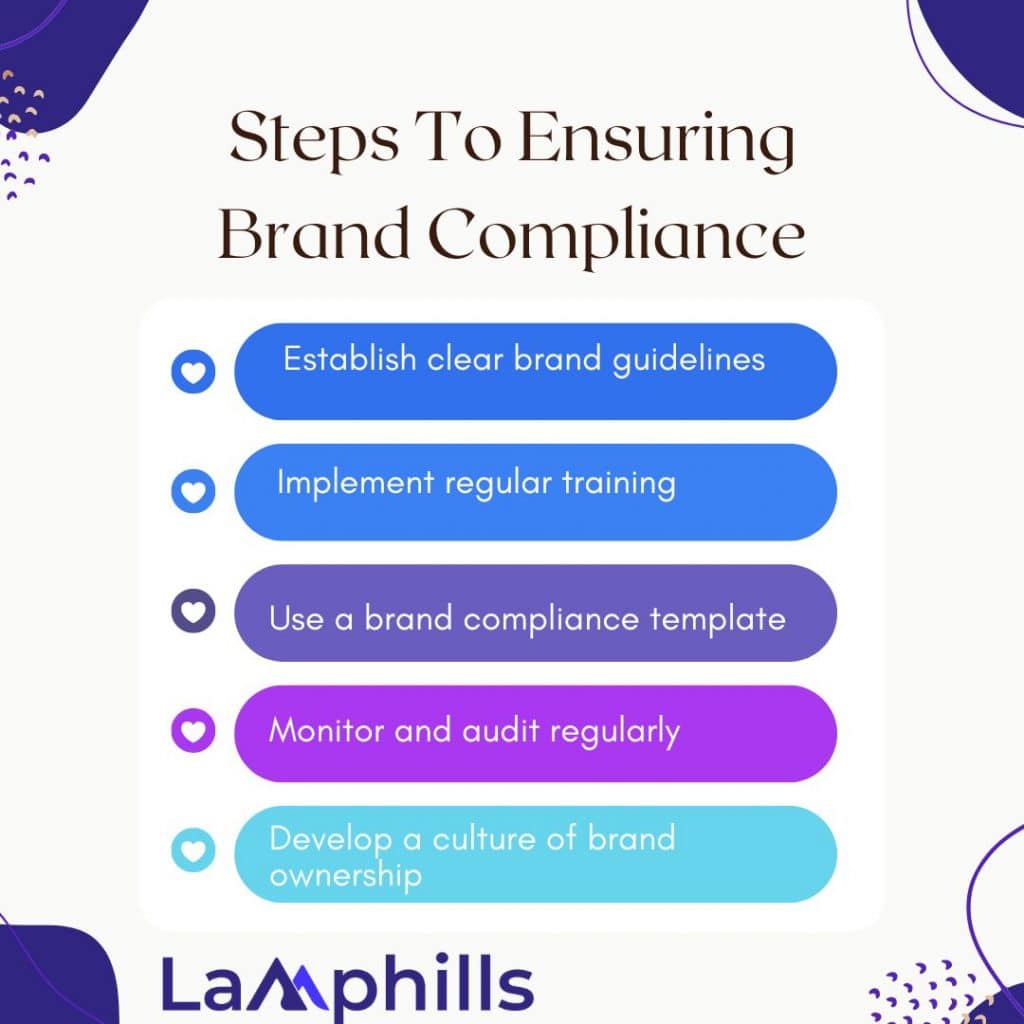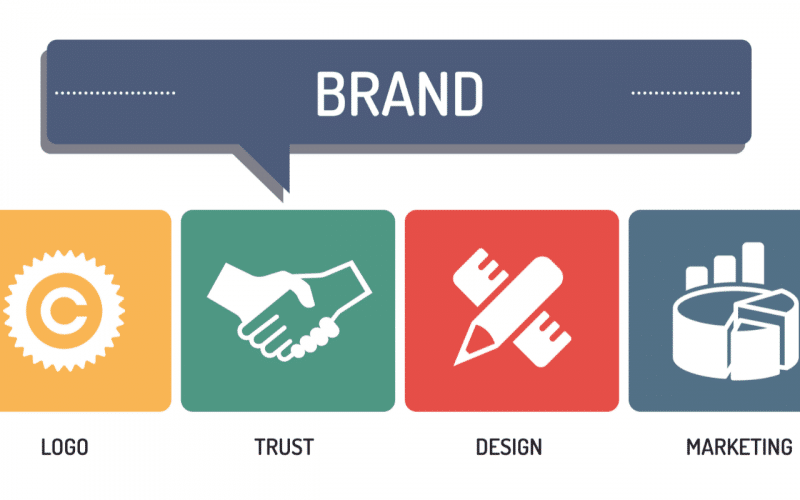Ever felt uneasy while going through a competitor’s website? Their branding appeared sleek and consistent; everything from their website design to their social media presence exuded expertise. Then you came upon a single off-brand blog post with a mismatched typeface and an unsettlingly informal tone. Inconsistency and a lack of brand compliance might have a long-term negative impact on potential customers. In today’s competitive marketplace, brand compliance is not a “nice to have”; it is a necessary component of establishing trust and credibility.
In this article, I’ll go over Brand Compliance 101, explaining what you need to know to secure your brand’s consistency and integrity across all platforms.
What is Brand Compliance?
Brand compliance refers to following defined criteria and standards that determine a brand’s look, feel, and messaging. It guarantees that all brand elements—logos, colors, typography, tone of voice, and so on—are consistently and correctly applied across all platforms and communications.
Why Brand Compliance Matters
Maintaining brand compliance is important for various reasons:
- Consistency: It contributes to a consistent brand experience, fostering trust and awareness among your target audience.
- Legal Protection: The proper use of brand assets can help to avoid legal complications linked to trademark infringement.
- Professionalism: Consistent brand appearance and messaging provide a professional and trustworthy image.
- Customer Loyalty: Consistent branding increases your customers’ loyalty and confidence because they know what to expect from your brand.
Steps To Ensuring Brand Compliance

Step #1. Establish clear brand guidelines.
The first step towards brand compliance is to create clear and thorough brand rules. These rules should encompass everything about your brand’s identity, including:
- Logo Usage: Indicate how and where your logo may be used, including variations, minimum sizes, and spacing.
- Color Palette: Define the specific colors that define your brand, such as primary, secondary, and accent colors.
- Typography: Describe the fonts used for various sorts of content, including headings, body text, and captions.
- Tone of Voice: Describe the style and tone of your brand’s communication, making sure it is consistent with your brand’s identity and values.
When we originally established our company, our brand rules were imprecise and poorly written. As a result, our marketing materials frequently appeared disconnected, and we received complaints regarding inconsistencies. It wasn’t until we hired a branding professional to provide comprehensive standards that our brand’s reputation improved significantly.
Step #2. Implement regular training
Regular training sessions for your team are required to ensure brand compliance. Ensure that everyone involved in developing and distributing content understands the brand guidelines and the importance of following them. This involves marketing departments, designers, and even external partners.
According to Lucidpress, a consistent brand presentation can boost sales by up to 23 percent. This statistic emphasizes the cost implications of maintaining brand compliance.
Step #3. Use a brand compliance template
A Brand Compliance Template can be a useful tool for ensuring that all content authors and stakeholders adhere to the brand requirements. This template may include checklists for logo usage, color checks, typography standards, and tone of voice alignment. You can use our free brand compliance checklist below.
Step #4. Monitor and audit regularly
Regular monitoring and auditing of your brand’s touchpoints is critical for ensuring compliance. Use tools and software to monitor how your brand is represented across multiple platforms. Conduct periodic audits to identify and address any deviations.
Tools such as Brandwatch and Hootsuite may help you track brand mentions and usage on social media and other digital channels, ensuring that your brand is appropriately portrayed.
Step #5. Develop a culture of brand ownership
Encourage your team to take ownership of the brand. When everyone feels accountable for maintaining brand integrity, they are more likely to follow the requirements. Celebrate instances of great brand compliance and offer constructive comments as needed.
Examples of Highly Disciplined Brands
There is no real debate among business students that this emphasis on brand discipline had a hugely favorable influence on the firms who took it seriously. Disciplined strategic branding has contributed to market-leading increases in revenue and corporate value in industries ranging from manufacturing to media to medical and beyond. In fact, the science of brand valuation emerged in the 1960s and 1970s precisely because the brand had become an extremely valuable asset on corporate balance sheets.
Specific examples of highly disciplined brands abound, of course—but a few examples here may help to highlight the critical role that brand-compliance programs have played over time.
#1. FedEx
At FedEx headquarters in Memphis, it’s often said that employees “bleed purple,” a reference to the company’s primary brand color and a testament to how deeply brand voice has permeated corporate culture. From the iconic FedEx logo to the livery of the ubiquitous FedEx trucks, the company has transformed the brand into a cultural icon.
With this emphasis on brand discipline, the company has accomplished one of the most difficult marketing feats: the successful creation of nearly a dozen “sub-brands” (FedEx Ground, FedEx Freight, FedEx Office, etc.), each drawing strength from the parent without diluting or confusing the master brand’s awareness and appeal. The same disciplined approach applies to FedEx’s B2B business, where sales collateral is subjected to the same level of brand scrutiny as a broadcast spot or national newspaper ad.
These are just a few of the many reasons why the FedEx brand was valued at more than $2.5 billion and increased by more than 33% in 2018.
#2. Chick-fil-A
Great brand compliance entails paying attention to every facet of the customer experience—and perhaps no company has done so more consistently than Chick-fil-A. Over the last decade, the company’s revenues have tripled from $2.5 billion to $10.5 billion, propelling it to third place in the quick service restaurant industry, with per-store sales more than three times higher than its largest direct competitor. The primary reason for this amazing success is the way Chick-fil-A operators embody and activate the brand—not just in communications, but in all aspects of employee training, menu development, and day-to-day operations.
#3. Ritz-Carlton
With approximately 200 properties throughout the world, The Ritz-Carlton Hotel Company has defined what it means to be a “luxury” brand.
Team members at every Ritz-Carlton property are referred to as “Ladies and Gentlemen,” and they are encouraged and supported to uphold those standards in all aspects of guest service.
This is an excellent example of how brand compliance is more than simply a set of regulations; it is a way of being, doing, and going about your day. You can also see the attention to brand discipline in the way that each property in the collection has a version of the logo dedicated to it—a graphic feature that speaks to originality yet supports the brand promise.
Common Challenges in Brand Compliance
Maintaining brand compliance is not without its problems, especially as your firm develops and evolves. Here are some frequent hurdles you might meet and techniques to overcome them, based on my personal experiences and observations.
#1. Decentralized Teams
In larger firms, it’s usual to have teams dispersed across several locations, sometimes even across the globe. This regional dispersion can lead to variations in how your brand is represented, as various teams might interpret and implement brand rules in varied ways.
When our company expanded abroad, we encountered considerable issues in maintaining brand consistency. Each regional office has its own method of doing things, resulting in differences in our branding materials. To overcome this, we used centralized brand management technologies such as Frontify and Brandfolder. These tools enabled us to keep all of our brand assets in one place, available to everyone, regardless of location. We also set up frequent virtual meetings to discuss brand improvements and ensure everyone was on the same page.
Use centralized brand management technologies to establish a single point of truth for your brand assets. These platforms enable you to save, distribute, and update brand guidelines and assets in real-time, ensuring that everyone has access to the most recent versions. Regular team communication and collaboration can also help to keep things consistent.
#2. Rapid growth
As businesses grow quickly, it becomes increasingly difficult to keep all team members on track with brand rules. New recruits, changing positions, and growing teams can cause misalignment and deviations from established brand standards.
During a period of tremendous expansion, our staff size doubled in six months. With so many new workers, it was difficult to guarantee everyone understood and followed our brand rules. We addressed this by including brand training in our onboarding process. Every new employee attended a brand session, where we went over our guidelines and stressed the necessity of brand compliance. We also built an easily available digital manual that staff may use at any time.
Regular training and changes to brand standards are essential. Incorporate brand training into your onboarding process to ensure new workers understand your brand’s standards from the start. Periodically evaluate and update your brand guidelines to reflect any changes or new directions, and ensure that these adjustments are clearly conveyed to all team members.
#3. External Partners
Working with external agencies or partners can result in variations in brand portrayal. These collaborators may not have as deep an understanding of your brand as your internal team, resulting in potential variances.
We once hired a marketing agency to manage a significant campaign. Despite giving them our brand rules, we discovered differences in the advertising materials. The agency’s depiction of our brand was not entirely consistent with our vision. To avoid this in the future, we initiated extensive brand orientation training with all external partners. These discussions involved going over our brand standards, showing them samples of acceptable items, and establishing clear expectations for brand compliance.
Ensure that all external collaborators have access to your brand’s standards and understand the significance of compliance. Conduct extensive brand orientation meetings with new partners, and show them samples of approved products to help them with their work. Regular check-ins and reviews can help detect inconsistencies early and assure alignment.
How Lamphills Can Help With Brand Compliance
Lamphills Media specializes in assisting businesses to achieve and maintain brand compliance. Our extensive services include the following:
- Brand audits: We evaluate your current brand compliance and find opportunities for improvement.
- Guideline Development: Our professionals generate precise and user-friendly brand guidelines based on your specifications.
- Training Programs: We provide training sessions to ensure your workforce understands and adheres to the brand rules.
Lamphills offers ongoing support to help you monitor and maintain brand compliance.
How To Track Brand Compliance On Your Website
While manually assessing your website’s content for brand consistency does require a significant amount of time, skill, and resources, adopting an automated brand compliance tool allows you to manage brand compliance considerably more efficiently, particularly on a big scale.
Alternatively, for a small firm with limited resources and branding experience, investing in an automated solution can be faster and less expensive than outsourcing these checks to an agency or attempting to perform everything in-house.
Digital brand compliance systems offer useful features such as:
- Asset libraries allow teams to get brand-compliant templates for use.
- Templating technologies enable marketers to create unique and dynamic on-brand templates for emails, social media postings, presentations, and other brand assets.
- Automated procedures ensure that content is vetted by the appropriate approvers before going live.
Brand managers can use customizable reporting to track the use of brand assets and gain performance insights.
Conclusion
Maintaining brand compliance is critical to creating a consistent, professional, and trustworthy brand. You can ensure your brand’s consistency across all touchpoints by defining clear standards, training your staff, employing a brand compliance template, checking regularly, and cultivating a culture of brand ownership. At Lamphills Media, we can assist you in negotiating the difficulties of brand compliance and achieving your branding objectives. So, how do you plan to take your brand compliance to the next level?
Related Articles
- BRAND ASSETS: 13 Examples That Will Strengthen Your Band
- BRAND RESONANCE: Elevating Brand Resonance Through Experiential Engagement
- The Top 2024 Brand Mention Tools (All You Need)
- PR Campaign Secrets: How Top Brands Dominate the Spotlight
- 9 Personal Branding Hacks for Insane Growth in 2024






